First-Principles Investigations on Structural and Elastic Properties of Orthorhombic TiAl under Pressure
Abstract
:1. Introduction
2. Computational Methodology
3. Results and Discussion
4. Conclusions
Acknowledgments
Author Contributions
Conflicts of Interest
References
- Kestler, H.; Clemens, H. Production, Processing and Application of γ(TiAl)-Based Alloys. In Titanium and Titantium Alloys; Leyens, C., Peters, M., Eds.; Wiley-VCH: Weinheim, Germany, 2003; p. 351. [Google Scholar]
- Abe, E.; Kumagai, T.; Nakamura, M. New ordered structure of TiAl studied by high-resolution electron microscopy. Intermetallics 1996, 4, 327–333. [Google Scholar] [CrossRef]
- Appel, F.; Oehring, M.; Paul, J.D.H. Nano-scale design of TiAl alloys based on β-phase decomposition. Adv. Eng. Mater. 2006, 8, 371–376. [Google Scholar] [CrossRef]
- Tanimura, M.; Inoue, Y.; Koyama, Y. Change in Al concentration profile related to the D019→L10 structural change in Ti-Al alloys. Scr. Mater. 2001, 44, 365–373. [Google Scholar] [CrossRef]
- Ducher, R.; Viguier, B.; Lacaze, J. Modification of the crystallographic structure of γ-TiAl alloyed with iron. Scr. Mater. 2002, 47, 307–313. [Google Scholar] [CrossRef]
- Schmoelzer, T.; Stark, A.; Schwaighofer, E.; Lippmann, T.; Mayer, S.; Clemens, H. In situ synchrotron study of B19 phase formation in an intermetallic γ-TiAl alloys. Adv. Eng. Mater. 2012, 14, 445–448. [Google Scholar] [CrossRef]
- Song, L.; Xu, X.J.; You, L.; Liang, Y.F.; Lin, J.P. B19 phase in Ti–45Al–8.5Nb–0.2W–0.2B–0.02Y alloy. J. Alloys Compd. 2015, 618, 305–310. [Google Scholar] [CrossRef]
- Nguyen-Manh, D.; Pettifor, D.G. Electronic structure, phase stability and elastic moduli of AB transition metal aluminides. Intermetallics 1999, 7, 1095–1106. [Google Scholar] [CrossRef]
- Nguyen-Manh, D.; Pettifor, D.G. Origin of O-Phase and Pseudo-Twinning in Ti-Al-Nb Alloys: A First-Principles Study. In Gamma Titanium Aluminides; Kim, Y.-W., Dimiduk, D.M., Loretto, M.H., Eds.; TMS: Warrendale, PA, USA, 1999; pp. 175–182. [Google Scholar]
- Holec, D.; Reddy, R.K.; Klein, T.; Clemens, H. Preferential site occupancy of alloying elements in TiAl-based phases. J. Appl. Phys. 2016, 119, 339–341. [Google Scholar] [CrossRef]
- Wen, Y.; Wang, L.; Liu, H.; Song, L. Ab initio study of the elastic and mechanical properties of B19 TiAl. Crystals 2017, 7, 39–49. [Google Scholar] [CrossRef]
- Blöchl, P.E. Projector augmented-wave method. Phys. Rev. B 1994, 50, 17953–17979. [Google Scholar] [CrossRef]
- Perdew, J.P.; Burke, K.; Ernzerhof, M. Generalized gradient approximation made simple. Phys. Rev. Lett. 1996, 77, 3865–3868. [Google Scholar] [CrossRef] [PubMed]
- Perdew, J.P.; Burke, K.; Ernzerhof, M. Generalized gradient approximation made simple. Phys. Rev. Lett. 1997, 78, 1396. [Google Scholar] [CrossRef]
- Kresse, G.; Furthmüller, J. Efficiency of ab-initio total energy calculations for metals and semiconductors using a plane-wave basis set. Comput. Mater. Sci. 1996, 6, 15–150. [Google Scholar] [CrossRef]
- Kresse, G.; Furthmüller, J. Efficient iterative schemes for ab initio total-energy calculations using a plane-wave basis set. Phys. Rev. B 1996, 54, 11169–11186. [Google Scholar] [CrossRef]
- Kresse, G.; Joubert, D. From ultrasoftpseudopotentials to the projector augmented-wave method. Phys. Rev. B 1999, 59, 1758–1775. [Google Scholar] [CrossRef]
- Monkhorst, H.J.; Pack, J.D. Special points for Brillouin-zone integrations. Phys. Rev. B 1976, 13, 5188–5192. [Google Scholar] [CrossRef]
- Le Page, Y.; Saxe, P. Symmetry-general least-squares extraction of elastic data for strained materials from ab initio calculations of stress. Phys. Rev. B 2002, 65, 104104–104117. [Google Scholar] [CrossRef]
- Wu, X.; Vanderbilt, D.; Hamann, D.R. Systematic treatment of displacements, and electric fields in density-functional perturbation theory. Phys. Rev. B 2005, 72, 035105–035117. [Google Scholar] [CrossRef]
- Hamann, D.R.; Wu, X.; Rabe, K.M.; Vanderbilt, D. Metric tensor formulation of strain in density-functional perturbation theory. Phys. Rev. B 2005, 71, 035117. [Google Scholar] [CrossRef]
- Erba, A. The internal-strain tensor of crystals for nuclear-relaxed elastic and piezoelectric constants: On the full exploitation of its symmetry features. Phys. Chem. Chem. Phys. 2016, 18, 13984–13992. [Google Scholar] [CrossRef] [PubMed]
- Erba, A.; Caglioti, D.; Dovesi, R. Nuclear-relaxed elastic and piezoelectric constants of materials: Computational aspects of two quantum-mechanical approaches. J. Comput. Chem. 2017, 38, 257–264. [Google Scholar] [CrossRef] [PubMed]
- Hill, R. The elastic behaviour of a crystalline aggregate. Proc. Phys. Soc. A 1953, 65, 349–354. [Google Scholar] [CrossRef]
- Voigt, W. Lehrbuch der Kristallphysik; Teubner: Leipzig, Germany, 1928. [Google Scholar]
- Reuss, A.; Angew, Z. Berechnung del fliessgrenze von mischkristallen auf grund der plastizitatbedingung for einkristalle. Math. Mech. 1929, 9, 49–58. [Google Scholar]
- Ravindran, P.; Fast, L.; Korzhavyi, P.A.; Johansson, B.; Wills, J.; Eriksson, O. Density functional theory for calculation of elastic properties of orthorhombic crystals: Application to TiSi2. J. Appl. Phys. 1998, 84, 4891–4904. [Google Scholar] [CrossRef]
- Chung, D.H.; Buessem, W.R. The elastic anisotropy of crystals. J. Appl. Phys. 1967, 38, 2010–2012. [Google Scholar] [CrossRef]
- Ranganathan, S.I.; Ostoja-Starzewski, M. Universal elastic anisotropy index. Phys. Rev. Lett. 2008, 101, 055504–055507. [Google Scholar] [CrossRef] [PubMed]
- Anderson, O.L. A simplified method for calculating the debye temperature from elastic constants. J. Phys. Chem. Solids 1963, 24, 909–917. [Google Scholar] [CrossRef]
- Schreiber, E.; Anderson, O.L.; Soga, N. Elastic Constants and Their Measurements; McGraw-Hill: New York, NY, USA, 1973. [Google Scholar]
- Erba, A.; Mahmoud, A.; Belmonte, D.; Dovesi, R. High pressure elastic properties of minerals from ab initio simulations: The case of pyrope, grossular and andradite silicate garnets. J. Chem. Phys. 2014, 140, 124703. [Google Scholar] [CrossRef] [PubMed]
- Mouhat, F.; Coudert, F.X. Necessary and sufficient elastic stability conditions in various crystal systems. Phys. Rev. B 2014, 90, 224104. [Google Scholar] [CrossRef]
- Chang, J.; Chen, X.R.; Wei, D.Q.; Yuan, X.L. Elastic constants and anisotropy of β-BC2N under pressure. Physica B 2010, 405, 3751–3755. [Google Scholar] [CrossRef]
- Birch, F. Finite elastic strain of cubic crystals. Phys. Rev. 1947, 71, 809–824. [Google Scholar] [CrossRef]
- Errandonea, D.; Meng, Y.; Somayazulu, M.; Hausermann, D. Pressure-induced α→ω transition in titanium metal: A systematic study of the effects of uniaxial stress. Phys. B 2005, 355, 116–125. [Google Scholar] [CrossRef]
- Dewaele, A.; Loubeyre, P.; Mezouar, M. Equations of state of six metals above 94 GPa. Phys. Rev. B 2004, 70, 094112. [Google Scholar] [CrossRef]
- Smith, D.; Joris, O.P.J.; Sankaran, A.; Weekes, H.E.; Bull, D.J.; Prior, T.J.; Dye, D.; Errandonea, D.; Proctor, J.E. On the high-pressure phase stability and elastic properties of β-titanium alloys. J. Phys. Condens. Matter 2017, 29, 155401. [Google Scholar] [CrossRef] [PubMed]
- Pugh, S.F. Relations between the elastic moduli and the plastic properties of polycrystalline pure metals. Philos. Mag. 1954, 45, 823–843. [Google Scholar] [CrossRef]
- Frantsevich, I.N.; Voronov, F.F.; Bokuta, S.A. Elastic Constants and Elastic Moduli of Metals and Insulators Handbook; Frantsevich, I.N., Ed.; Naukova Dumka: Kiev, Ukraine, 1983; pp. 60–180. [Google Scholar]
- Pettifor, D. Theoretical predictions of structure and related properties of intermetallics. Mater. Sci. Technol. 1992, 8, 345–349. [Google Scholar] [CrossRef]
- Teter, D.M. Computational alchemy: The search for new superhard materials. MRS Bull. 1998, 23, 22–27. [Google Scholar] [CrossRef]
- Errandonea, D.; Ferrer-Roca, C.; Martinez-Carcia, D.; Segura, A.; Gomis, O.; Munoz, A.; Rodriguez-Hernandez, P.; Lopez-Solnano, J.; Alconchel, S.; Sapina, F. High-pressure X-ray diffraction and ab initio study of Ni2Mo3N, Pd2Mo3N, Pt2Mo3N, Co3Mo3N, and Fe3Mo3N: Two families of ultra-incompressible bimetallic interstitial nitrides. Phys. Rev. B 2010, 82, 174105. [Google Scholar] [CrossRef]
- Liu, L.L.; Xu, G.; Wang, A.R.; Wu, X.Z.; Wang, R. First-principles investigations on structure stability, elastic properties, anisotropy and Debye temperature of tetragonal LiFeAs and NaFeAs under pressure. J. Phys. Chem. Solids 2017, 104, 243–251. [Google Scholar] [CrossRef]
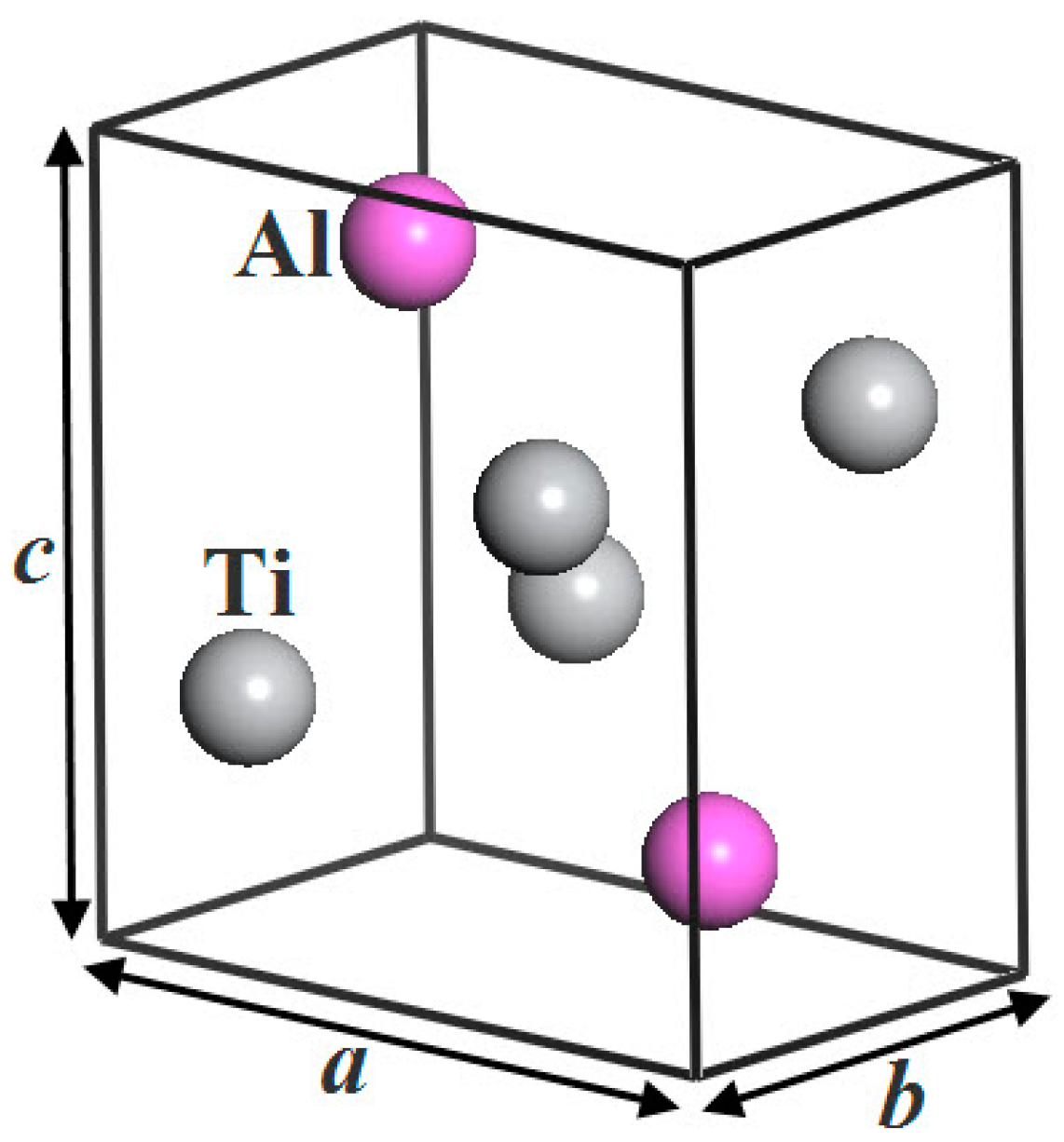
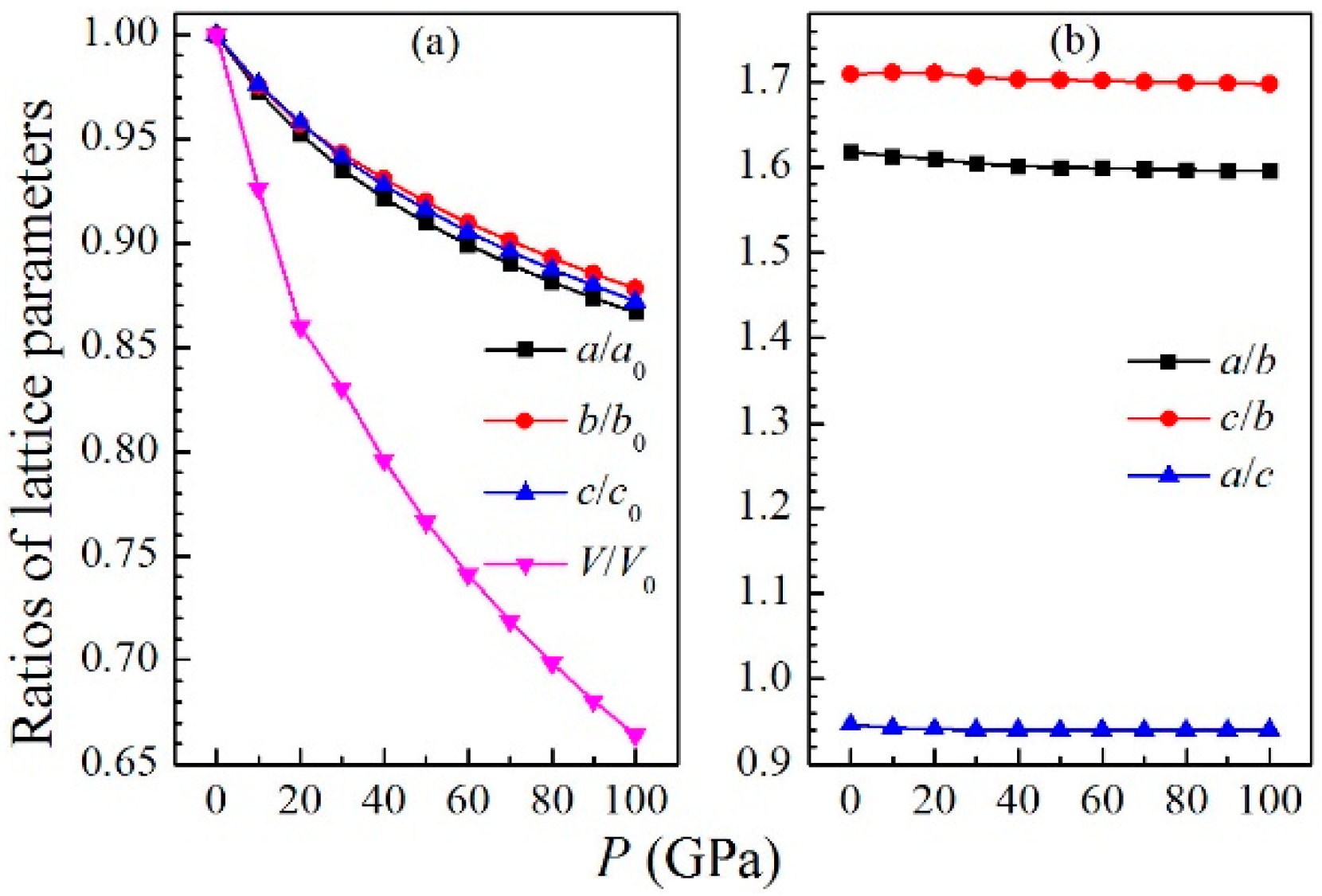
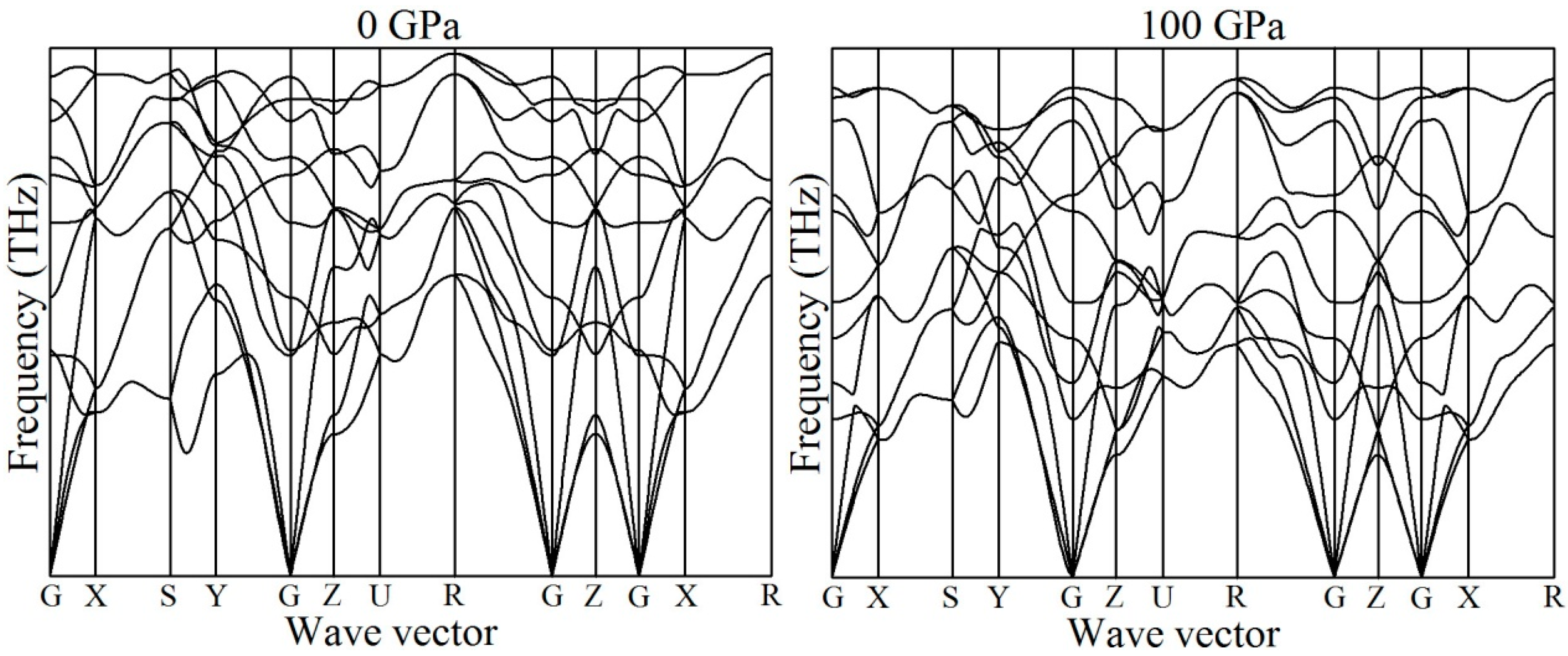
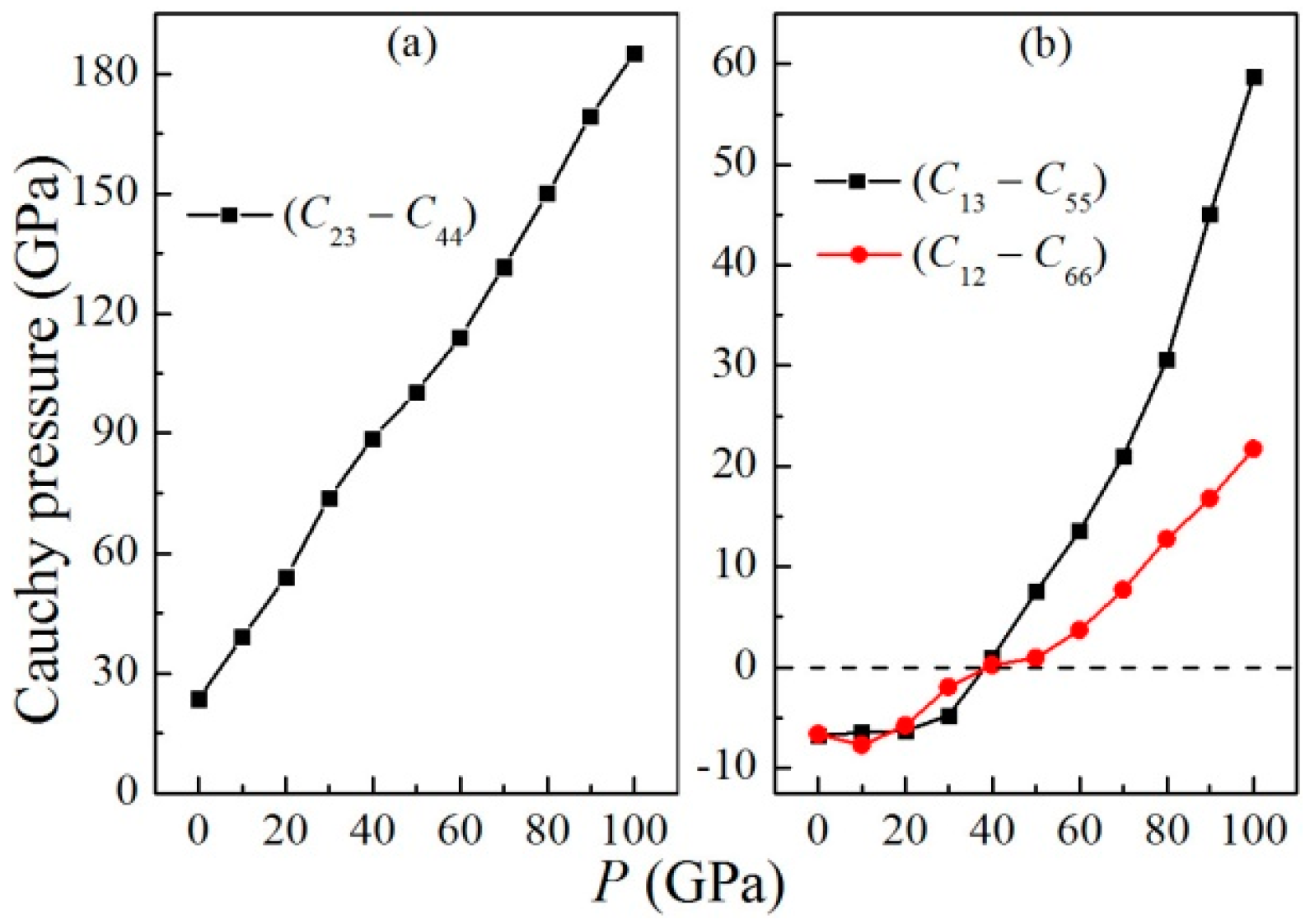
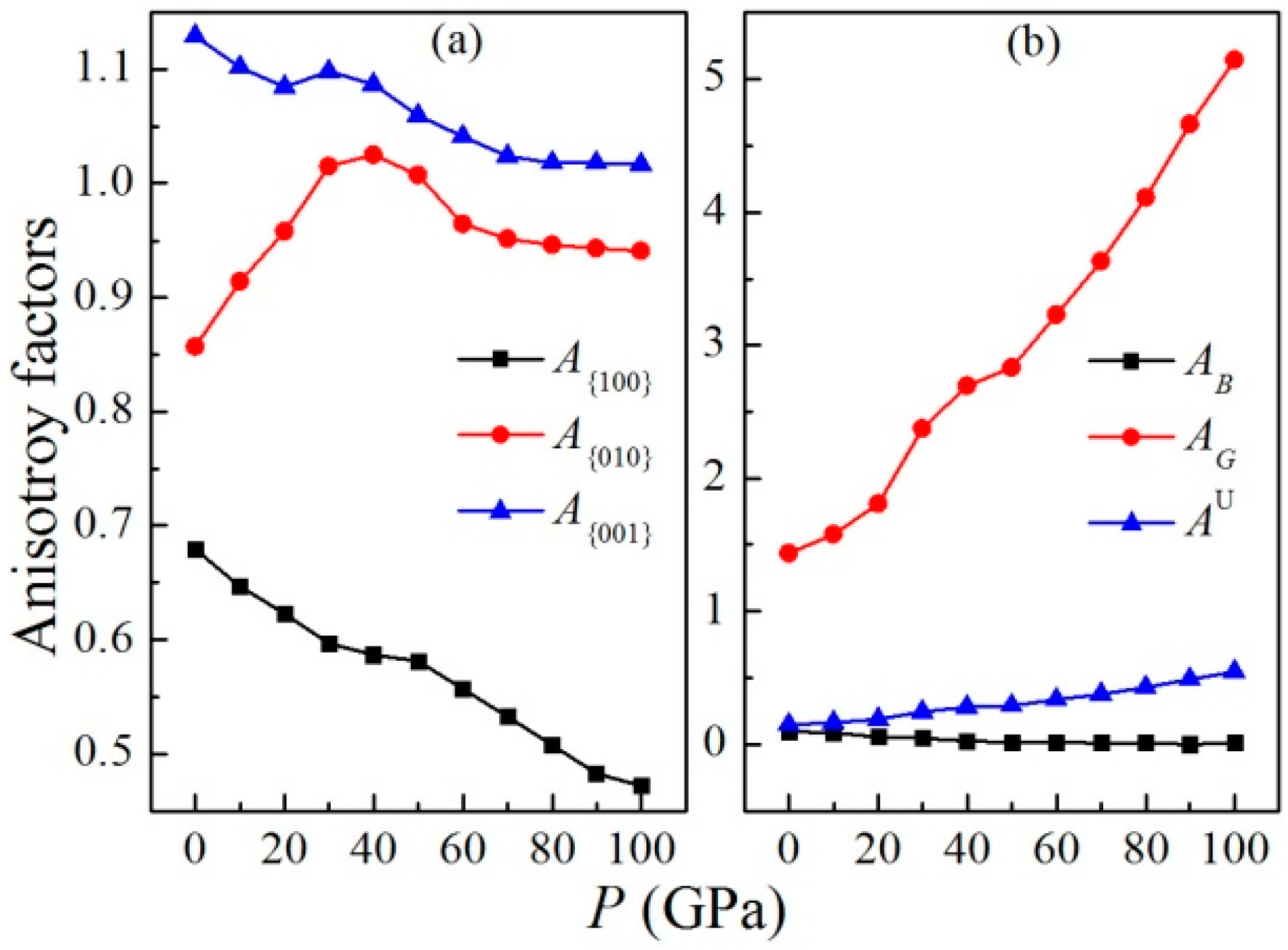
| Method | Lattice Parameter (Å) | Atom (Wyckoff) | Atomic Coordinates | ||
|---|---|---|---|---|---|
| x | y | z | |||
| Exp. [2] | a = 4.50, b = 2.80, c = 4.90 | ||||
| Exp. [6] | a = 4.65, b = 2.828, c = 4.94 | Ti (2e) | 1/4 | 0 | 5/6 |
| Al (2f) | 1/4 | 1/2 | 1/3 | ||
| Present | a = 4.632, b = 2.863, c = 4.895 | Ti (2e) | 1/4 | 0 | 0.83983 |
| Al (2f) | 1/4 | 1/2 | 0.33919 | ||
| P | C11 | C12 | C13 | C22 | C23 | C33 | C44 | C55 | C66 |
|---|---|---|---|---|---|---|---|---|---|
| 0 | 206.90 | 68.03 | 47.40 | 193.56 | 79.65 | 218.56 | 56.15 | 54.17 | 74.66 |
| 10 | 260.12 | 83.71 | 61.45 | 239.30 | 104.51 | 267.14 | 65.40 | 67.95 | 91.45 |
| 20 | 309.50 | 99.74 | 72.87 | 279.31 | 127.09 | 305.42 | 73.06 | 79.20 | 105.55 |
| 30 | 355.40 | 116.64 | 81.78 | 309.93 | 152.57 | 336.49 | 78.80 | 86.60 | 118.61 |
| 40 | 399.59 | 130.41 | 93.43 | 340.45 | 174.01 | 368.51 | 85.28 | 92.50 | 130.20 |
| 50 | 441.64 | 141.36 | 105.53 | 371.18 | 192.30 | 402.62 | 92.01 | 98.05 | 140.47 |
| 60 | 482.66 | 154.15 | 114.05 | 403.73 | 209.87 | 432.78 | 95.75 | 100.53 | 150.48 |
| 70 | 518.99 | 165.85 | 124.43 | 430.46 | 229.20 | 462.66 | 97.52 | 103.41 | 158.18 |
| 80 | 552.09 | 178.17 | 135.87 | 454.08 | 247.04 | 484.82 | 97.05 | 105.24 | 165.41 |
| 90 | 581.41 | 188.91 | 151.06 | 472.70 | 263.88 | 504.37 | 94.58 | 105.97 | 172.14 |
| 100 | 610.47 | 200.27 | 164.36 | 492.73 | 279.07 | 514.74 | 94.00 | 105.66 | 178.59 |
| P | BV | BR | B | Beq | GV | GR | G | G/B | E | ν | Hv |
|---|---|---|---|---|---|---|---|---|---|---|---|
| 0 | 112.13 | 111.92 | 112.02 | 112.39 | 65.26 | 63.41 | 64.33 | 0.574 | 161.99 | 0.259 | 8.936 |
| 10 | 140.66 | 140.42 | 140.54 | 140.08 | 79.42 | 76.95 | 78.18 | 0.556 | 197.86 | 0.265 | 9.889 |
| 20 | 165.96 | 165.77 | 165.87 | 165.68 | 91.20 | 87.96 | 89.58 | 0.540 | 227.73 | 0.271 | 10.489 |
| 30 | 189.31 | 189.14 | 189.23 | 188.60 | 100.19 | 95.54 | 97.87 | 0.517 | 250.43 | 0.279 | 10.500 |
| 40 | 211.58 | 211.47 | 211.53 | 211.41 | 108.98 | 103.26 | 106.12 | 0.502 | 272.75 | 0.285 | 10.675 |
| 50 | 232.64 | 232.59 | 232.62 | 231.84 | 117.86 | 111.37 | 114.61 | 0.493 | 295.33 | 0.288 | 11.006 |
| 60 | 252.81 | 252.75 | 252.78 | 251.99 | 125.43 | 117.59 | 121.51 | 0.481 | 314.18 | 0.293 | 11.081 |
| 70 | 272.34 | 272.29 | 272.31 | 270.15 | 131.33 | 122.12 | 126.73 | 0.465 | 329.13 | 0.299 | 10.872 |
| 80 | 290.34 | 290.29 | 290.32 | 287.69 | 135.53 | 124.83 | 130.18 | 0.448 | 339.75 | 0.305 | 10.491 |
| 90 | 307.35 | 307.34 | 307.35 | 306.74 | 138.18 | 125.87 | 132.03 | 0.430 | 346.47 | 0.312 | 9.965 |
| 100 | 322.82 | 322.76 | 322.79 | 324.27 | 140.60 | 126.84 | 133.72 | 0.414 | 352.48 | 0.318 | 9.495 |
| P | ρ | Vt | Vl | Vm | ΘD |
|---|---|---|---|---|---|
| 0 | 3.8295 | 4098.8 | 7187.0 | 4555.2 | 535.50 |
| 10 | 4.1342 | 4348.7 | 7694.7 | 4836.7 | 583.29 |
| 20 | 4.4531 | 4485.1 | 8004.2 | 4991.8 | 617.09 |
| 30 | 4.6106 | 4607.2 | 8327.3 | 5133.0 | 641.94 |
| 40 | 4.8113 | 4696.4 | 8565.8 | 5236.0 | 664.19 |
| 50 | 4.9962 | 4789.6 | 8783.3 | 5342.1 | 686.22 |
| 60 | 5.1670 | 4849.3 | 8959.8 | 5411.7 | 702.99 |
| 70 | 5.3290 | 4876.6 | 9099.9 | 5446.0 | 714.77 |
| 80 | 5.4810 | 4873.5 | 9199.7 | 5447.0 | 721.63 |
| 90 | 5.6266 | 4844.0 | 9268.8 | 5419.1 | 724.23 |
| 100 | 5.7673 | 4815.2 | 9321.1 | 5390.9 | 726.42 |
© 2017 by the authors. Licensee MDPI, Basel, Switzerland. This article is an open access article distributed under the terms and conditions of the Creative Commons Attribution (CC BY) license (http://creativecommons.org/licenses/by/4.0/).
Share and Cite
Liu, L.; Wu, X.; Wang, R.; Nie, X.; He, Y.; Zou, X. First-Principles Investigations on Structural and Elastic Properties of Orthorhombic TiAl under Pressure. Crystals 2017, 7, 111. https://doi.org/10.3390/cryst7040111
Liu L, Wu X, Wang R, Nie X, He Y, Zou X. First-Principles Investigations on Structural and Elastic Properties of Orthorhombic TiAl under Pressure. Crystals. 2017; 7(4):111. https://doi.org/10.3390/cryst7040111
Chicago/Turabian StyleLiu, Lili, Xiaozhi Wu, Rui Wang, Xiangfei Nie, Yelu He, and Xing Zou. 2017. "First-Principles Investigations on Structural and Elastic Properties of Orthorhombic TiAl under Pressure" Crystals 7, no. 4: 111. https://doi.org/10.3390/cryst7040111





